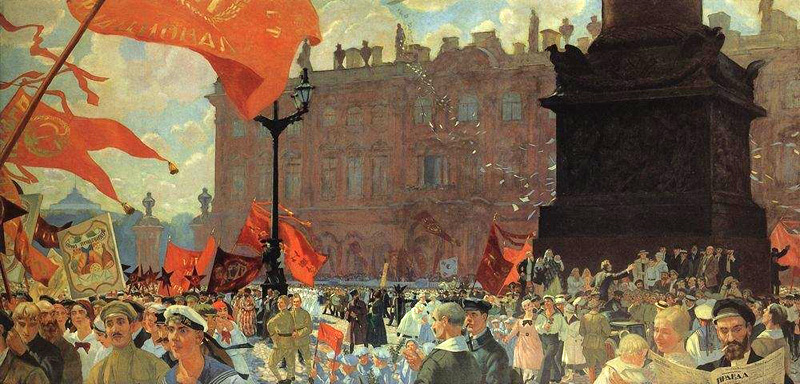“I am a product of the Soviet era,” Olga Lepeshinskaya said in an interview. She really was a person of her time – in the best sense.
Faster, Higher, Stronger
Lepeshinskaya came from an aristocratic family, yet grew up in the realities of the USSR – she was born a year before the Russian Revolution. Her father was a railway engineer; Olga dreamt of working as an engineer too. She imagined herself constructing big bridges and driving powerful trains across them.
The future ballerina found her real calling thanks to her mother. Having noticed that Olga loved to dance, Mariya Lepeshinskaya enrolled the girl in the Bolshoi Ballet Academy.
The admissions committee initially rejected Lepeshinskaya because she had a short stature and not very graceful legs. Luckily, fate itself stepped in – one “right” candidate decided not to enter the school and Olga filled the vacant spot. Lepeshinskaya very soon became the best pupil in her class.
Her success wasn’t easy. She practiced far more than most of her classmates. Here is an impressive example of her perseverance. Olga had problems with the notorious thirty-two fouettés (spins) – she did six and fell. The girl asked the watchman to let her in the training hall after the lessons. There she repeated the exercise over and over again. Finally, she has completed the thirty-two fouettés without any mistakes… Do you think Olga stopped there? Nothing of the sort! She learned to perform sixty-four!
Lepeshinskaya graduated and was accepted into the Bolshoi Theatre. The young ballerina quickly got solo parts. So lively, so bright, she always stood out from the rest. Olga Lepeshinskaya smiled in flights, her eyes sparkled. The ballerina’s partners joked that it would be possible to light a cigar from her.
Lepeshinskaya danced in both classical and modern performances. In particular, she was long associated with the role of Jeanne in Flames of Paris. She also brilliantly starred as Kitri in Don Quixote and Tao Hoa in The Red Poppy.
Living a Full Life
At the beginning of the 1940s, Soviet ballets were very rarely recorded. The unique recording from 1940 that I’m going to show you appeared owing to a happy coincidence – Lepeshinskaya’s first husband was a film director.
The number is called the Mozskowski waltz (music by Moritz Mozskowski, choreography by Vasili Vainonen). We can see a touching scene of a date. Olga Lepeshinskaya and her partner Pyotr Gusev are running toward one another. It seems to us that they will hug; however, they just join their palms. This is not demanding passion but timid first love.
The dancers magnificently convey the sentiments of the inexperienced lovers. They feel happy like children and almighty like gods – if HE needs me, I am beautiful; if SHE needs me, I’ll move mountains.
It’s obvious that the number is extremely difficult. Lepeshinskaya and Gusev perform all the moves impeccably though. Look, for instance, how easily the ballerina turns twice in the air in just two seconds (3:15 – 3:17). Lepeshinskaya liked high-flying leaps and dangerous lifts.
Her energy was inexhaustible. She literally threw herself into the dance. Sometimes the ballerina’s dresser had to hold her by the skirt while Olga waited in the wings for her entrance, otherwise she could jump out on the stage too soon.
This youthful exuberance was the spirit of the epoch. People tried to fill their lives up to the edges. Professional dancers willingly dug potatoes together with collective farm workers. The fragile ballerinas went skydiving before the performance and spent the evening after it in a shooting gallery to get the honorary title of “Voroshilov sharpshooter”. Lepeshinskaya had it – she hit the bullseye even from the prone position.
The Sun Still Shines
In June 1941, the Bolshoi Theater was preparing for a new season. The war changed the artists’ plans. Many of them, including Lepeshinskaya, immediately decided to volunteer for the army. The ballerina was rejected. “Why, comrades?! – she got upset, “I am a Voroshilov sharpshooter!” She tried to sign up as a nurse. Unfortunately (or fortunately?), this attempt also failed.
The theater started to form so-called front brigades before long. The brigades of artists went to the front line and performed different short numbers for the soldiers. Olga Lepeshinskaya joined one of these groups.
The following video is another rarity. This is a fragment of the documentary “The Soviet Art” filmed in 1942. Olga Lepeshinskaya and the same male partner, Gusev, dance next to a hospital on the bank of the Volga river. Recovering soldiers are smiling – some had probably never seen a ballet before. The war is dreadful, but life continues. The sun still shines.
The dance is a waltz again; it is performed to cheerful music by Dulov. The dancers are dressed in everyday clothes, not classical ballet costumes, as if they are a common soviet boy and girl from a neighbor’s yard (actually, Lepeshinskaya didn’t often put on a tutu – she preferred a tunic). Lepeshinskaya demonstrates powerful technique and an exuberant joie de vivre.
The spectators would hardly have known that this “stage” wasn’t good enough to perform a ballet on. For ballet dancers, the special stage is critically important; if there are the smallest deviations from the standard, it ruins their joints. Olga Lepeshinskaya agreed to dance anywhere – on stone slabs, on sand, in the back of the truck. She participated in brigade concerts during the whole war – four years. Not surprisingly, it was hard for Lepeshinskaya to walk in old age.
The artists of the Bolshoi worked in the front line without a material reward. The money they earned went to the Defence Fund and was later used to build a warplane.
Lepeshinskaya danced for Red Army soldiers in Austria, Romania, Hungary, Bulgaria, Yugoslavia… On Victory Day, she was in the capital of Poland. The ballerina reminisced:
When we arrived in Warsaw, there was no one there. The buildings were destroyed, not a single person. And suddenly, on the Victory Day, crowds of people arose. Where did they appear from – out of the ground? But they all came to watch the concert. I danced three times then, because one spectator left and another came. The spectators cried.
That same evening, Olga Lepeshinskaya was handed a telegram. The choreographer Rostislav Zakharov asked her to return to Moscow immediately – he got down to work on the new ballet. Cinderella; Lepeshinskaya was to be the star. She showed up at the Bolshoi Theater in ugly boots and a quilted jacket.
The audience received Cinderella warmly. Tired of grief and losses, people wanted to dive into a fairy tale with a happy ending.
Sunset
She left the Bolshoi in 1963 at the age of 47. The main reason was her mental state rather than her physical health: she no longer felt any joy from being on the stage.
By 1963, Lepeshinskaya had been through so much… Her second spouse was arrested as an alleged participant in the fabricated Zionist Plot, and they had divorced after his release from prison – maybe he didn’t want to jeopardize Lepeshinskaya’s reputation. The ballerina’s third husband had died unexpectedly. Formerly an atheist, Lepeshinskaya started to believe in God.
She said goodbye to the stage, but not to ballet. Having retired, Olga Lepeshinskaya began teaching classical in the Soviet Union and other countries. The ballerina taught as long as she could.
- Вселенная русского балета [The Universe of the Russian Ballet] – Илзе Лиепа, АСТ, Москва, 2020
- Olga Lepeshinskaya – Mary Clarke, The Guardian, Sat 24 Jan 2009
- Ольга Лепешинская. Если ты в прошлое выстрелишь из пистолета, то будущее в тебя выстрелит из пушки [Olga Lepeshinskaya. If you shoot into the past with a pistol, the future will shoot you from a cannon]. Archived from the original on June 5, 2008. Retrieved September 13, 2008 – Наталья Пятницына, www.world-war.ru

